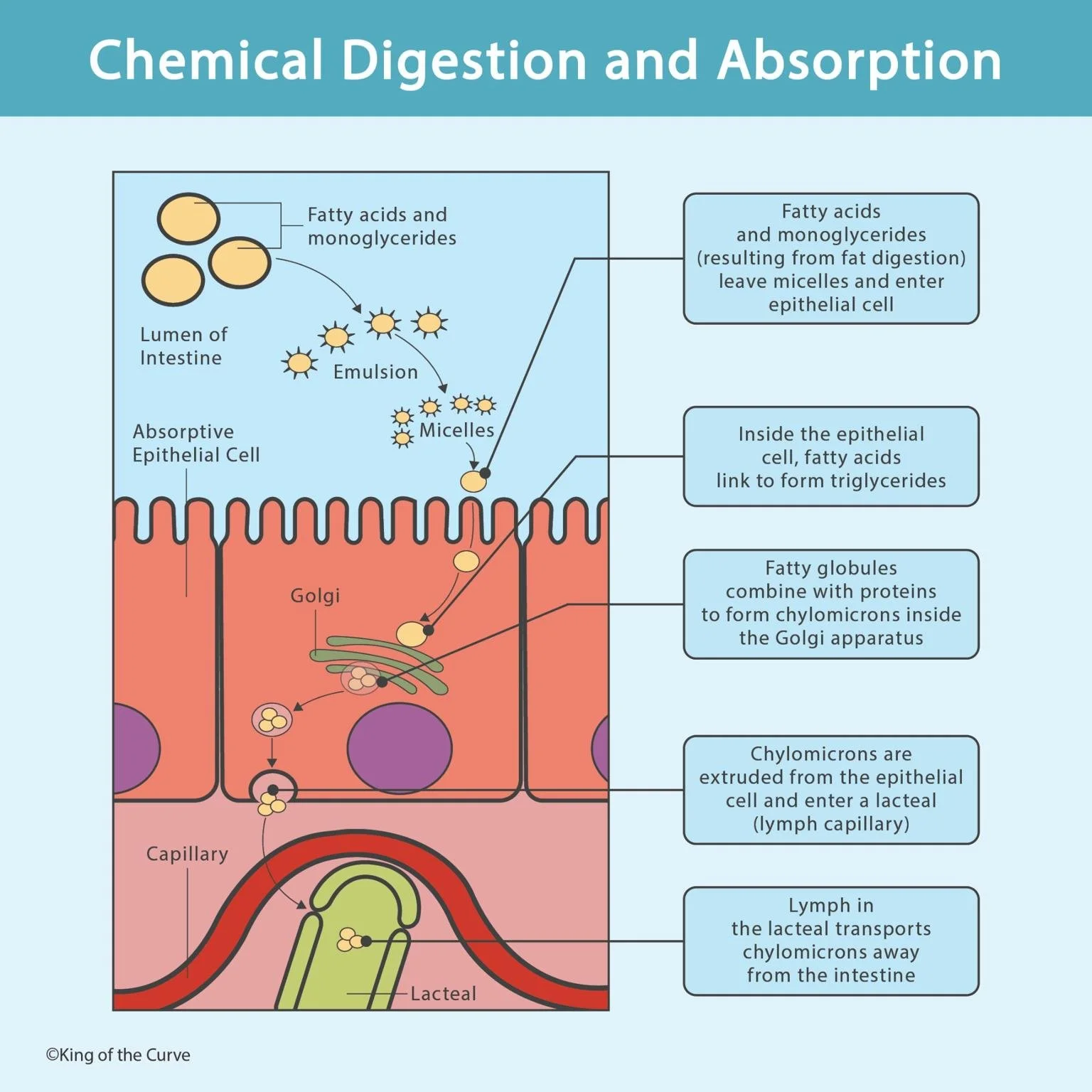🥑 Chemical Digestion and Absorption: Fat Breakdown and Uptake
Fats are an essential energy source, but their digestion and absorption require specialized processes because lipids are hydrophobic. The small intestine is the main site for lipid breakdown, micelle formation, and absorption into the lymphatic system. Understanding this pathway is crucial for MCAT biochemistry and NCLEX nutrition-related physiology.
🧪 Emulsification and Micelle Formation
In the lumen of the intestine, large fat globules from dietary intake are emulsified by bile salts into smaller droplets. This increases surface area, allowing pancreatic lipase to break triglycerides into fatty acids and monoglycerides. These products then combine with bile salts to form micelles — small transport structures that can navigate the watery intestinal environment.
🚪 Entry into Epithelial Cells
Micelles transport fatty acids and monoglycerides to the brush border membrane of absorptive epithelial cells. Here, the lipids leave the micelles and diffuse into the cells. This step does not require transporters because lipids are nonpolar and can pass through the lipid bilayer by simple diffusion.
🏭 Triglyceride Reassembly and Chylomicron Formation
Inside the epithelial cell, fatty acids are linked together with glycerol to reform triglycerides. These triglycerides combine with proteins in the Golgi apparatus to form chylomicrons — large lipoprotein particles specialized for lipid transport.
📊 Summary of Fat Absorption Steps
| Step | Process | Location |
|---|---|---|
| 1 | Emulsification by bile salts | Lumen of small intestine |
| 2 | Lipase digestion into fatty acids & monoglycerides | Lumen |
| 3 | Micelle formation | Lumen |
| 4 | Diffusion into epithelial cells | Brush border |
| 5 | Triglyceride reassembly | Inside epithelial cell |
| 6 | Chylomicron formation | Golgi apparatus |
| 7 | Transport via lacteals | Lymphatic system |
💡 MCAT Tip: Lipids bypass the hepatic portal vein initially — they enter the lymphatic system first through lacteals before reaching the bloodstream.
🩺 Clinical Relevance for Exams
MCAT: Expect questions on why lipid-soluble vitamins (A, D, E, K) follow the same absorption path as fats.
NCLEX: Understand how conditions like celiac disease or bile salt deficiency impair fat absorption, leading to steatorrhea (fatty stools).
Pharmacology: Lipophilic drugs may require emulsification for optimal absorption.
🚀 Call to Action
Boost your mastery of digestive physiology with King of the Curve’s Adaptive Q-Bank, daily challenges, and 1,000+ science visuals. Perfect for MCAT and NCLEX prep.
📲 Start your free lifetime access today and make learning effortless.
Frequently Asked Questions (FAQs)
-
Aim for 4-6 focused hours, ensuring you incorporate breaks to avoid burnout.
-
Practice mindfulness techniques, take practice exams under realistic conditions, and maintain a balanced lifestyle.
-
Set short-term goals, seek support from mentors, and reward yourself for small achievements.
-
Regular exercise improves focus, reduces stress, and enhances overall mental clarity.
-
KOTC offers personalized learning tools, gamification features, and adaptive question banks to help students stay on track without burnout.


